Simulation of Soil Water Transport and Utilization in an Apple–Soybean Alley Cropping System Under Different Irrigation Methods Based on HYDRUS-2D
Abstract
:1. Introduction
2. Materials and Methods
2.1. Field Experiment
2.1.1. Location
2.1.2. Design of Field Experiment
2.1.3. Measurement of Meteorological Data, Soil Moisture Content, Leaf Area, and Plant Height
2.2. Numerical Modeling
2.2.1. Water Flow Equations
2.2.2. Domain and Boundary Conditions
2.2.3. Root Water Uptake
2.2.4. Estimating Evaporation and Transpiration
2.2.5. Criteria of Model Evaluation
2.2.6. Calculation of Irrigation Amount and Total Water Use
2.2.7. Water Productivity
3. Results
3.1. Model Evaluation
3.2. Water Content Dynamics at Different Depths in the Apple–Soybean Alley Cropping System
3.3. Dynamic Characteristics of Soil Water Content Distribution at Different Levels in the Apple–Soybean Alley Cropping System
3.4. Water Productivity of Soybean Throughout Its Entire Growing Season in the Apple–Soybean Alley Cropping System
4. Discussion
4.1. Spatial Dynamics of Water Distribution in the Apple–Soybean Alley Cropping System Based on HYDRUS-2D
4.2. Water Use and Irrigation Optimization Strategies in the Apple–Soybean Alley Cropping System Under Different Irrigation Methods and Water Volumes Based on HYDRUS-2D
5. Conclusions
Author Contributions
Funding
Data Availability Statement
Acknowledgments
Conflicts of Interest
References
- Xie, J.; Wang, L.; Li, L.; Anwar, S.; Luo, Z.; Zechariah, E.; Fudjoe, S.K. Yield, Economic Benefit, Soil Water Balance, and Water Use Efficiency of Intercropped Maize/Potato in Responses to Mulching Practices on the Semiarid Loess Plateau. Agriculture 2021, 11, 1100. [Google Scholar] [CrossRef]
- Wang, Z.; Wu, Y.; Cao, Q.; Shen, Y.; Zhang, B. Modeling the coupling processes of evapotranspiration and soil water balance in agroforestry systems. Agric. Water Manag. 2021, 250, 106839. [Google Scholar] [CrossRef]
- Sun, Y.; Bi, H.; Xu, H.; Duan, H.; Peng, R.; Wang, J. Below-Ground Interspecific Competition of Apple (Malus pumila M.)–Soybean (Glycine max L. Merr.) Intercropping Systems Based Niche Overlap Loess Plateau China. Sustainability 2018, 10, 3022. [Google Scholar]
- Dou, X.; Wang, R.; Zhou, X.; Gao, F.; Yu, Y.; Li, C.; Zheng, C. Soil water, nutrient distribution and use efficiencies under different water and fertilizer coupling in an apple–maize alley cropping system in the Loess Plateau, China. Soil Tillage Res. 2022, 218, 105308. [Google Scholar] [CrossRef]
- Wang, L.; Wang, R.; Luo, C.; Dai, H.; Xiong, C.; Wang, X.; Zhang, M.; Xiao, W. Effects of Different Soil Water and Heat Regulation Patterns on the Physiological Growth and Water Use in an Apple–Soybean Intercropping System. Agronomy 2023, 13, 511. [Google Scholar] [CrossRef]
- Dou, X.; Wang, R.; Li, C.; Zheng, C.; Zhou, X. Spatial distribution of soil water, plant roots, and water use pattern under different drip fertigation regimes in an apple-soybean intercropping system on the Loess Plateau, China. Agric. Water Manag. 2022, 269, 107718. [Google Scholar] [CrossRef]
- Yin, W.; Yu, A.; Guo, Y.; Wang, Y.; Zhao, C.; Fan, Z.; Falong, H.; Chai, Q. Straw retention and plastic mulching enhance water use via synergistic regulation of water competition and compensation in wheat-maize intercropping systems. Field Crops Res. 2018, 229, 78–94. [Google Scholar] [CrossRef]
- Gao, Y.; Duan, A.; Qiu, X.; Liu, Z.; Sun, J.; Zhang, J.; Wang, H. Distribution of roots and root length density in a maize/soybean strip intercropping system. Agric. Water Manag. 2010, 98, 99–212. [Google Scholar] [CrossRef]
- Zhang, Y.; Sun, Z.; Su, Z.; Du, G.; Bai, W.; Wang, Q.; Wang, R.; Nie, J.; Sun, T.; Feng, C.; et al. Root plasticity and interspecific complementarity improve yields and water use efficiency of maize/soybean intercropping in a water-limited condition. Field Crops Res. 2022, 282, 108523. [Google Scholar] [CrossRef]
- Dilla, A.; Smethurst, P.J.; Barry, K.; Parsons, D.; Denboba, M. Potential of the APSIM model to simulate impacts of shading on maize productivity. Agrofor. Syst. 2017, 92, 1699–1709. [Google Scholar] [CrossRef]
- Eugenia, G.A.; Angélique, C.; Magali, P.; Romain, B.; Gaëlle, R.; Alejandro, P.J.; Thierry, S.; Benoît, P. Effects of acclimation to long-term shading on photosynthesis in grapevines: Roles of non-structural carbohydrates and stomatal conductance. Physiol. Plant. 2024, 176, e14636. [Google Scholar]
- Lin, D.; Jin, Y.; Li, Y. Spatial pattern and water-saving mechanism of wheat and maize under the condition of strip-ridge intercropping. Acta Agric. Boreali-Occident. Sin. 2014, 23, 56–63. [Google Scholar]
- Mbangiwa, N.C.; Savage, M.J.; Mabhaudhi, T. Modelling and measurement of water productivity and total evaporation in a dryland soybean crop. Agric. For. Meteorol. 2019, 266–267, 65–72. [Google Scholar] [CrossRef]
- Dabach, S.; Lazarovitch, N.; Šimůnek, J.; Shani, U. Numerical investigation of irrigation scheduling based on soil water status. Irrig. Sci. 2013, 31, 27–36. [Google Scholar] [CrossRef]
- Simunek, J.; van Genuchten, M.T.; Sejna, M. Development and applications of the HYDRUS and STANMOD software packages and related codes. Vadose Zone J. 2008, 72, 587–600. [Google Scholar] [CrossRef]
- Allen, R.G.; Pereira, L.S.; Raes, D.; Smith, M. Crop evapotranspiration: Guidelines for computing crop water requirements, Agricultural and Food Sciences. Environ. Sci. 1998, 300, D05109. [Google Scholar]
- Chen, N.; Li, X.; Šimůnek, J.; Shi, H.; Zhang, Y.; Hu, Q. Quantifying inter-species nitrogen competition in the tomato-corn intercropping system with different spatial arrangements. Agric. Syst. 2022, 201, 103461. [Google Scholar] [CrossRef]
- Chen, N.; Li, X.; Šimůnek, J.; Shi, H.; Hu, Q.; Zhang, Y. Evaluating soil nitrate dynamics in an intercropping dripped ecosystem using HYDRUS-2D. Sci. Total Environ. 2020, 718, 137314. [Google Scholar] [CrossRef]
- Su, K.; Mu, L.; Zhou, T.; Yang, H. Quantifying spatiotemporal transfer of soil water and salt between intercrop root zones under alfalfa/spring wheat strip intercropping based on HYDRUS-2D. Agric. Ecosyst. Environ. 2024, 375, 109172. [Google Scholar] [CrossRef]
- Matteau, J.P.; Gumiere, S.J.; Gallichand, J.; Létourneau, G.; Khiari, L.; Gasser, M.O.; Michaud, A. Coupling of a nitrate production model with HYDRUS to predict nitrate leaching. Agric. Water Manag. 2019, 231, 616–626. [Google Scholar] [CrossRef]
- Surendran, U.; Chandran, K.M. Development and evaluation of drip irrigation and fertigation scheduling to improve water productivity and sustainable crop production using HYDRUS. Agric. Water Manag. 2022, 269, 107668. [Google Scholar] [CrossRef]
- Jia, Q.; Shi, H.; Li, R.; Miao, Q.; Feng, Y.; Wang, N.; Li, J. Evaporation of maize crop under mulch film and soil covered drip irrigation: Field assessment and modelling on West Liaohe Plain, China. Agric. Water Manag. 2021, 253, 106894. [Google Scholar] [CrossRef]
- Richards, L. Capillary conduction of liquids in soil through porous media. Physics 1931, 1, 318–333. [Google Scholar] [CrossRef]
- van Genuchten, M.T. A closed-form equation for predicting the hydraulic conductivity of unsaturated soils. Soil Sci. Soc. Am. 1980, 44, 892–898. [Google Scholar] [CrossRef]
- Giannakoulias, S.; Shringari, S.R.; Liu, C.; Phan, H.A.T.; Barrett, T.M.; Ferrie, J.J.; Petersson, E.J. Rosetta Machine Learning Models Accurately Classify Positional Effects of Thioamides on Proteolysis. J. Phys. Chem. B 2020, 124, 8032–8041. [Google Scholar] [CrossRef] [PubMed]
- Han, M.; Zhao, C.; Feng, G.; Yan, Y.; Sheng, Y. Evaluating the effects of mulch and irrigation amount on soil water distribution and root zone water balance using HYDRUS-2D. Water 2015, 7, 2622–2640. [Google Scholar] [CrossRef]
- Feddes, R.A.; Kowalik, P.J.; Zaradny, H. Simulation of field water use and crop yield. Soil Sci. 1982, 129, 193. [Google Scholar]
- Wesseling, J.G.; Brandyk, T. Introduction of the Occurrence of High Groundwater Levels and Surface Water Storage in Computer Program SWATRE; Institute for Land and Water Management Research (ICW): Wageningen, The Netherlands, 1985. [Google Scholar]
- Pereira, L.S.; Paredes, P.; Hunsaker, D.J.; López-Urrea, R.; Mohammadi Shad, Z. Standard single and basal crop coefficients for field crops. Updates and advances to the FAO56 crop water requirements method. Agric. Water Manag. 2021, 243, 106466. [Google Scholar] [CrossRef]
- López-Urrea, R.; Oliveira, C.M.; Montoya, F.; Paredes, P.; Pereira, L.S. Single and basal crop coefficients for temperate climate fruit trees, vines and shrubs with consideration of fraction of ground cover, height, and training system. Irrig. Sci. 2024, 42, 1099–1135. [Google Scholar] [CrossRef]
- Fernández, J.E.; Alcon, F.; Diaz-Espejo, A.; Hernandez-Santana, V.; Cuevas, M.V. Water use indicators and economic analysis for on-farm irrigation decision: A case study of a super high density olive tree orchard. Agric. Water Manag. 2020, 237, 106074. [Google Scholar] [CrossRef]
- Pereira, L.S.; Cordery, I.; Iacovides, I. Improved indicators of water use performance and productivity for sustainable water conservation and saving. Agric. Water Manag. 2012, 108, 39–51. [Google Scholar] [CrossRef]
- Liu, J.; Gao, X.; Song, J.; Wen, M.; Wang, J.; Cai, Y.; Zhao, X. Subsurface drip irrigation mitigated greenhouse gas emission and improved root growth and yield in apple in semi-arid region. Agric. Water Manag. 2025, 308, 109290. [Google Scholar] [CrossRef]
- Fu, Y.; Cao, Y.; Wang, H.; He, Z.; Wang, S. The effects of different fertilizer rates on water and nitrogen transport characteristics in the wetted body of bubbled-root irrigation. Arab. J. Geosci. 2021, 14, 1876. [Google Scholar] [CrossRef]
- Chen, Y.; Zhang, J.; Wang, Z.; Li, H.; Chen, R.; Zhao, Y.; Huang, T.; Luo, P. Influence of Long-Term Mulched Drip Irrigation on Upward Capillary Water Movement Characteristics in the Saline–Sodic Region of Northwest China. Agronomy 2024, 14, 1300. [Google Scholar] [CrossRef]
- Raz-Yaseef, N.; Rotenberg, E.; Yakir, D. Effects of spatial variations in soil evaporation caused by tree shading on water flux partitioning in a semi-arid pine forest. Agric. For. Meteorol. 2010, 150, 454–462. [Google Scholar] [CrossRef]
- Wang, Y.; Jiang, Y.; Zhao, Y.; Li, X.; Xie, K.; Yan, T.; Wei, T.; Li, P.; Li, H. Modeling the impact of long-term land use changes on deep soil hydrological processes in the Loess Plateau, China. J. Hydrol. 2024, 643, 131944. [Google Scholar] [CrossRef]
- Green, S.; Clothier, B. The root zone dynamics of water uptake by a mature apple tree. Plant Soil 1998, 206, 61–77. [Google Scholar] [CrossRef]
- Boini, A.; Manfrini, L.; Morandi, B.; Grappadelli, L.C.; Predieri, S.; Daniele, G.M.; López, G. High Levels of Shading as A Sustainable Application for Mitigating Drought, in Modern Apple Production. Agronomy 2021, 11, 422. [Google Scholar] [CrossRef]
- Bandala, M.G.; Rovelo, C.O.R.; Bautista-Capetillo, C.; González-Trinidad, J.; Júnez-Ferreira, H.E.; Palestina, M.S.; Martínez, H.P.; de Avila, H.M.; Recendez, M.I.R. Analysis of Irrigation Performance of a Solid-Set Sprinkler Irrigation System at Different Experimental Conditions. Water 2022, 14, 2641. [Google Scholar] [CrossRef]
- Hamdy, A. Water use efficiency in irrigated agriculture: An analytical review. ResearchGate 2007, 57, 9–19. [Google Scholar]
- Gajić, B.; Kresović, B.; Tapanarova, A.; Životić, L.; Todorović, M. Effect of irrigation regime on yield, harvest index and water productivity of soybean grown under different precipitation conditions in a temperate environment. Agric. Water Manag. 2018, 210, 224–231. [Google Scholar] [CrossRef]
- Wei, Z.; Paredes, P.; Liu, Y.; Chi, W.W.; Pereira, L.S. Modelling transpiration, soil evaporation and yield prediction of soybean in North China Plain. Agric. Water Manag. 2015, 147, 43–53. [Google Scholar] [CrossRef]
- Zheng, H.; Wang, B.; Cao, X.; Wu, J.; Yan, H.; Tian, D. Optimization of Subsurface Drip Irrigation Schedule of Alfalfa in Northwest China. Water 2023, 15, 2242. [Google Scholar] [CrossRef]
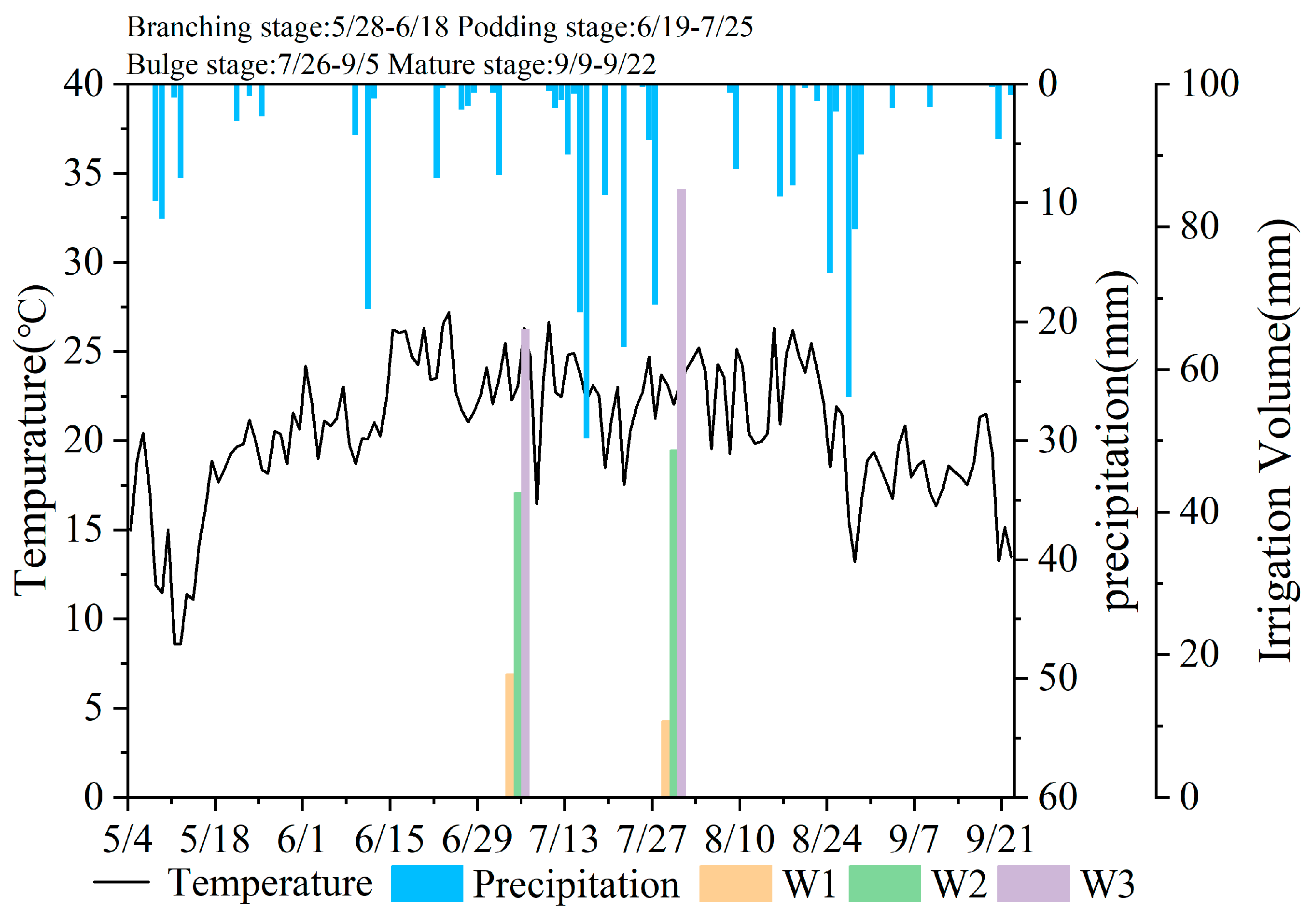

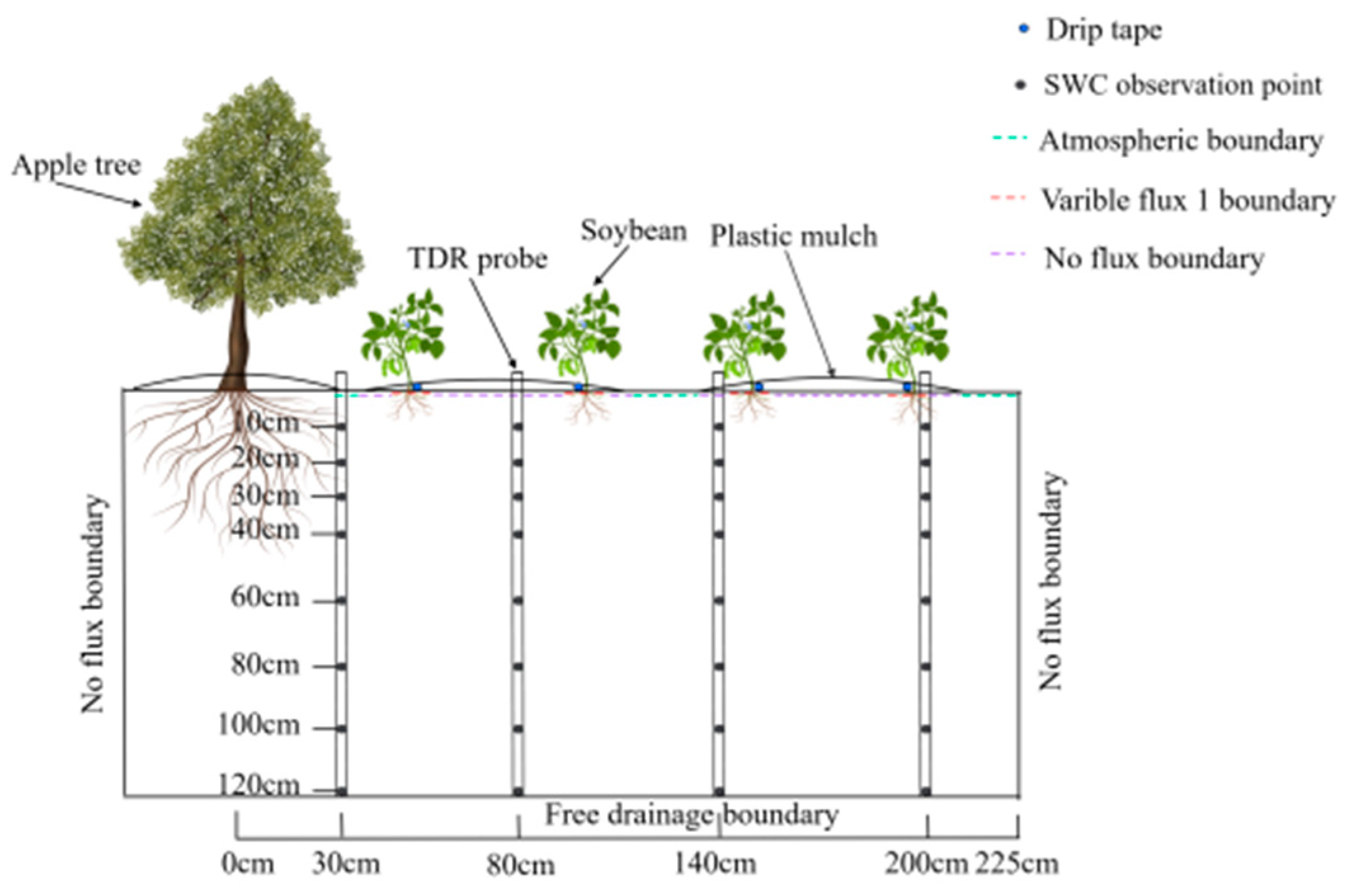


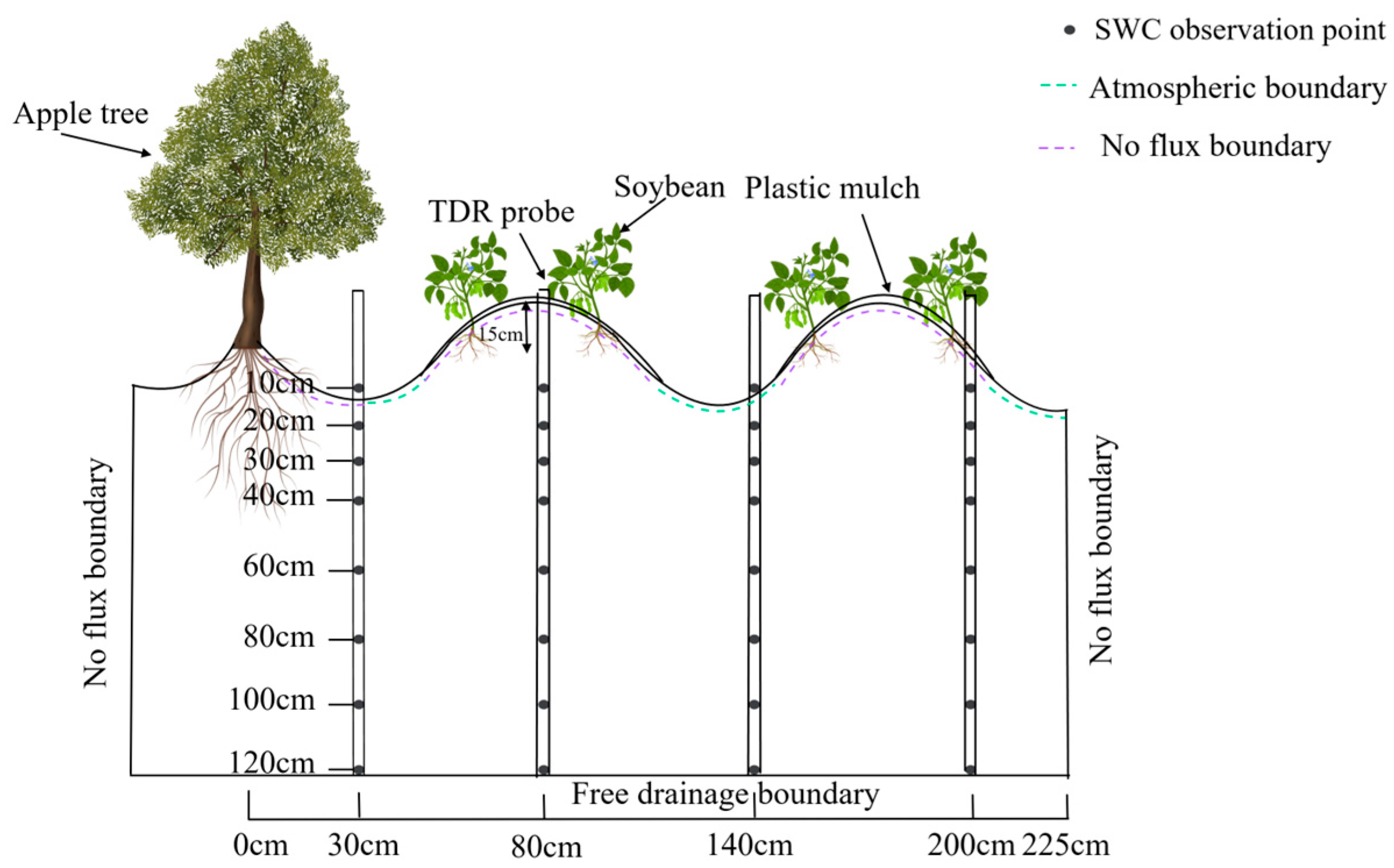

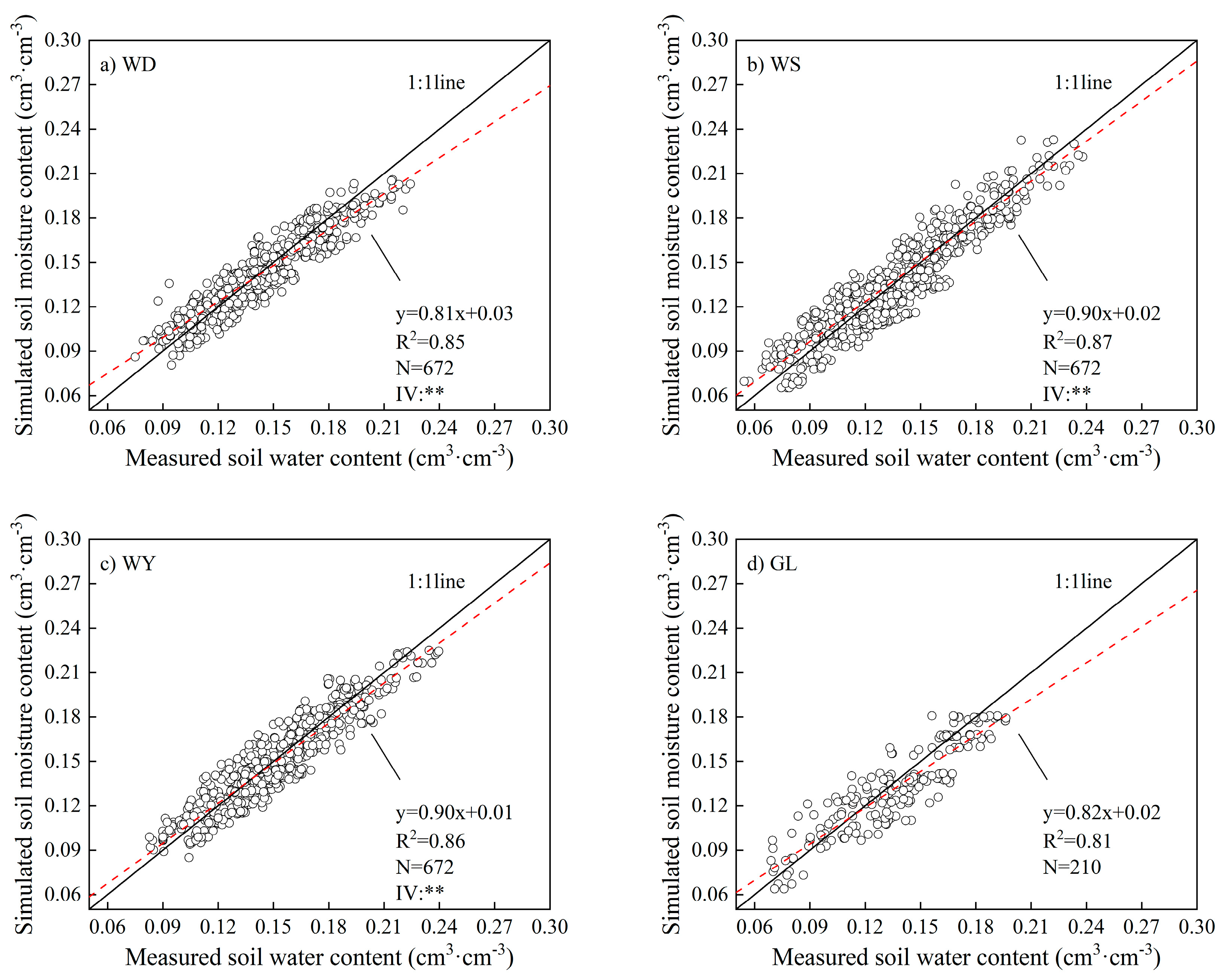


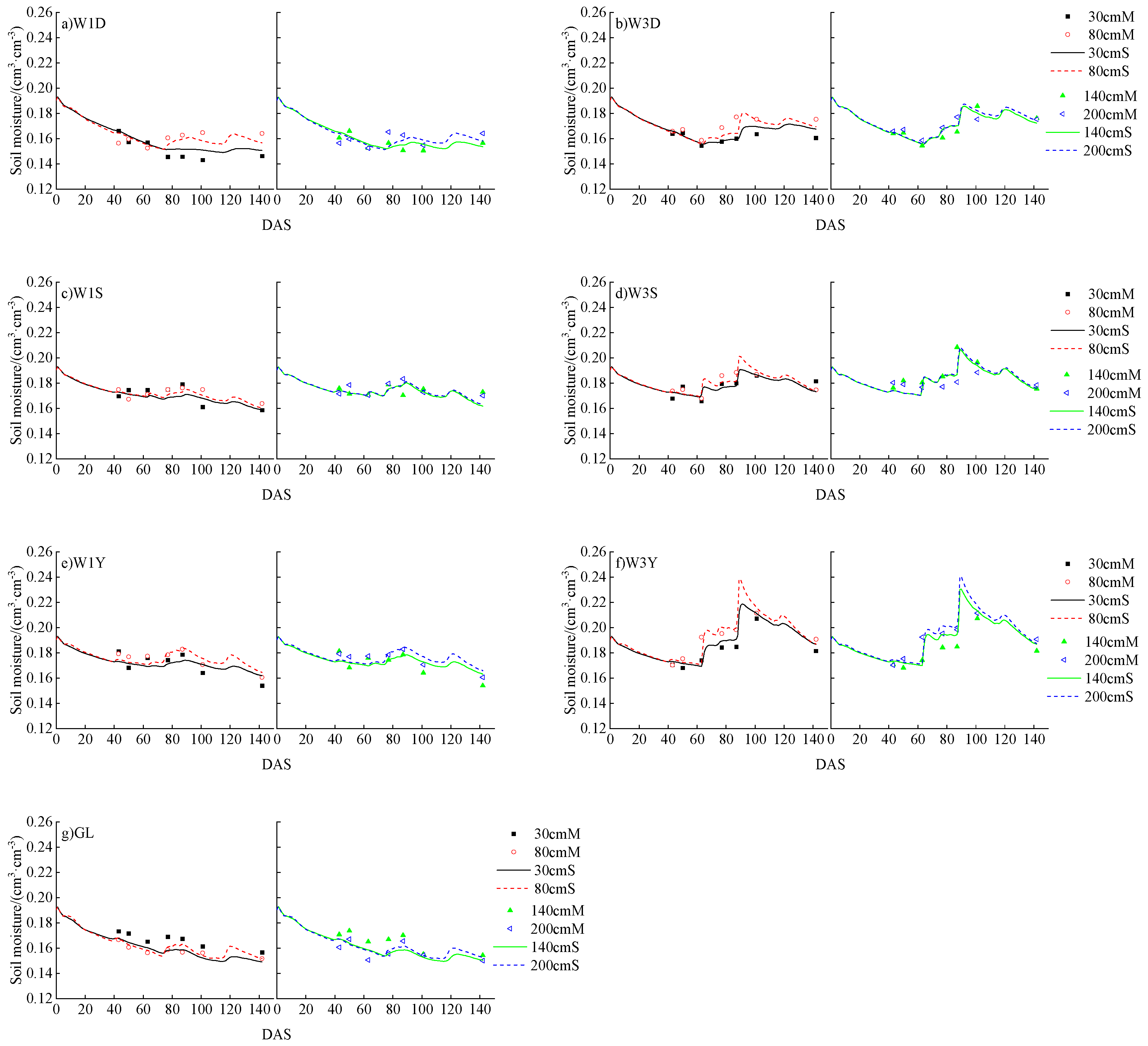

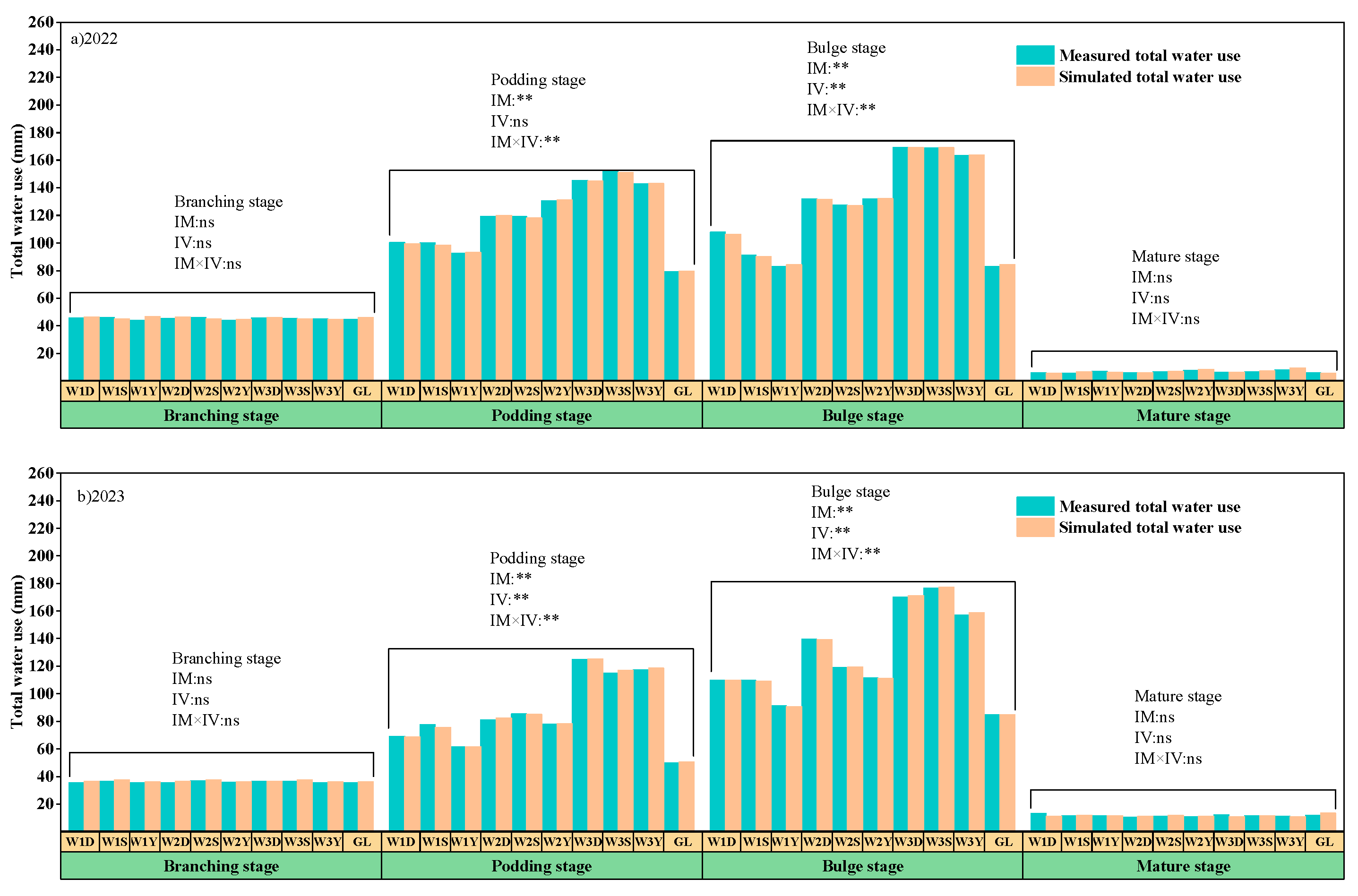

| Soil Layer (cm) | Soil Texture | Soil Particle Size Distribution (%) | Bulk Density | Field Capacity | ||
|---|---|---|---|---|---|---|
| Sand | Silt | Clay | (g·cm−3) | (cm3·cm−3) | ||
| 0–10 | Sandy loam | 23.2 | 72.5 | 4.2 | 1.11 | 0.28 |
| 10–20 | Loam | 45.5 | 50.5 | 4.0 | 1.20 | 0.28 |
| 20–30 | Loam | 47.5 | 48.9 | 3.6 | 1.31 | 0.26 |
| 30–40 | Loam | 42.5 | 54.5 | 2.9 | 1.39 | 0.26 |
| 40–60 | Loam | 47.4 | 48.1 | 3.9 | 1.30 | 0.27 |
| 60–80 | Loam | 43.9 | 51.8 | 4.3 | 1.28 | 0.26 |
| 80–100 | Loam | 40.4 | 57.4 | 2.2 | 1.29 | 0.27 |
| 100–120 | Loam | 39.8 | 57.1 | 3.1 | 1.28 | 0.27 |
| Micro-Irrigation Method | Irrigation Volume | Irrigation Amount/mm | |||
|---|---|---|---|---|---|
| Pod-Setting Stage | Grain-Filling Stage | Pod-Setting Stage | Grain-Filling Stage | ||
| 2022/7/6 | 2022/7/30 | 2023/6/10 | 2023/7/10 | ||
| D | W1 | 20.1 | 23.8 | 19.1 | 24.9 |
| W2 | 40.1 | 49.8 | 31.2 | 53.9 | |
| W3 | 65.1 | 87.1 | 72.2 | 85.4 | |
| S | W1 | 19.5 | 7.9 | 26.2 | 23.8 |
| W2 | 38.8 | 45.8 | 35.3 | 34.1 | |
| W3 | 71.2 | 87.5 | 65.1 | 91.9 | |
| Y | W1 | 12.3 | 0.6 | 12.1 | 6.0 |
| W2 | 49.3 | 50.6 | 26.6 | 25.9 | |
| W3 | 60.5 | 81.0 | 61.9 | 72.3 | |
| GL | 0 | 0 | 0 | 0 | 0 |
| Soil Layer (cm) | Residual Soil Water Content θr | Saturated Soil Water Content θs | Shape Parameter α | Shape Parameter n | Saturated Hydraulic Conductivity ks |
|---|---|---|---|---|---|
| (cm3·cm−3) | (cm3·cm−3) | (cm−1) | (-) | (cm·day−1) | |
| 0–10 | 0.051 | 0.440 | 0.020 | 1.71 | 100.00 |
| 10–20 | 0.054 | 0.393 | 0.005 | 2.53 | 80.00 |
| 20–30 | 0.053 | 0.371 | 0.011 | 1.69 | 60.00 |
| 30–40 | 0.054 | 0.353 | 0.009 | 1.64 | 50.00 |
| 40–60 | 0.053 | 0.374 | 0.011 | 1.62 | 70.00 |
| 60–80 | 0.051 | 0.371 | 0.023 | 1.40 | 74.42 |
| 80–100 | 0.053 | 0.370 | 0017 | 1.33 | 84.25 |
| 100–120 | 0.050 | 0.374 | 0.011 | 1.34 | 86.21 |
| Growth Stage | Research-Based Kc | Locally Calibrated Kc | Composite Kc | ||
|---|---|---|---|---|---|
| Apple | Soybean | Apple | Soybean | Alley Cropping System | |
| Early-season | 0.43 | 0.5 | 0.43 | 0.5 | 0.59 |
| Mid-season | 0.68 | 1.15 | 0.7 | 1.17 | 0.98 |
| Late-season | 0.4 | 1.05 | 0.4 | 0.98 | 0.85 |
| Year | Error | Treatments | |||
|---|---|---|---|---|---|
| WD | WS | WY | GL | ||
| 2022 | MAE (cm3·cm−3) | 0.014 | 0.011 | 0.014 | 0.011 |
| MRE (%) | 9.44 | 6.63 | 8.35 | 7.30 | |
| RMSE (cm3·cm−3) | 0.017 | 0.014 | 0.016 | 0.013 | |
| 2023 | MAE (cm3·cm−3) | 0.009 | 0.011 | 0.010 | 0.012 |
| MRE (%) | 6.95 | 7.16 | 6.72 | 9.28 | |
| RMSE (cm3·cm−3) | 0.011 | 0.013 | 0.012 | 0.014 | |
Disclaimer/Publisher’s Note: The statements, opinions and data contained in all publications are solely those of the individual author(s) and contributor(s) and not of MDPI and/or the editor(s). MDPI and/or the editor(s) disclaim responsibility for any injury to people or property resulting from any ideas, methods, instructions or products referred to in the content. |
© 2025 by the authors. Licensee MDPI, Basel, Switzerland. This article is an open access article distributed under the terms and conditions of the Creative Commons Attribution (CC BY) license (https://creativecommons.org/licenses/by/4.0/).
Share and Cite
Zhang, X.; Wang, R.; Dai, H.; Wang, L.; Chen, L.; Zheng, H.; Yu, F. Simulation of Soil Water Transport and Utilization in an Apple–Soybean Alley Cropping System Under Different Irrigation Methods Based on HYDRUS-2D. Agronomy 2025, 15, 993. https://doi.org/10.3390/agronomy15040993
Zhang X, Wang R, Dai H, Wang L, Chen L, Zheng H, Yu F. Simulation of Soil Water Transport and Utilization in an Apple–Soybean Alley Cropping System Under Different Irrigation Methods Based on HYDRUS-2D. Agronomy. 2025; 15(4):993. https://doi.org/10.3390/agronomy15040993
Chicago/Turabian StyleZhang, Xueying, Ruoshui Wang, Houshuai Dai, Lisha Wang, Li Chen, Huiying Zheng, and Feiyang Yu. 2025. "Simulation of Soil Water Transport and Utilization in an Apple–Soybean Alley Cropping System Under Different Irrigation Methods Based on HYDRUS-2D" Agronomy 15, no. 4: 993. https://doi.org/10.3390/agronomy15040993
APA StyleZhang, X., Wang, R., Dai, H., Wang, L., Chen, L., Zheng, H., & Yu, F. (2025). Simulation of Soil Water Transport and Utilization in an Apple–Soybean Alley Cropping System Under Different Irrigation Methods Based on HYDRUS-2D. Agronomy, 15(4), 993. https://doi.org/10.3390/agronomy15040993





